A place of many natural attractions, Bull Island now had a new visiting star, a flamingo, courtesy of Tropical Storm Idalia. The storm had transported many of these birds from the Yucatan throughout the southeast and even to Ohio and Wisconsin. These pink creatures became magnets for a range of people from ornithologists to more casual observers. The event incited flamingomania locally and beyond (a quick Google search confirmed I was not the originator of this term).
This flamingo was an accidental, a term for birds found outside of their normal or seasonal range. Roger Tory Peterson described them as “the rarest of rarities – birds that should not occur in your region at all.” This summer another storm, Hurricane Lee, bestowed on England a gift for their birders – a variety of North American birds. For Lowcountry birders, the news, photos, and videos spread quickly, and generated a steady stream of people heading out to capture their own views and photos.
I was not in the first or earlier waves, but finally surrendered to the prospect of seeing this pink bird in my backyard, and headed out on the ferry Caretta to the island. There were about ten passengers that September day, two of whom had the unmistakable look of serious birders, walking out the long concrete pier to the ferry with binoculars already trained on birds along the marsh and in the air.
I took the opportunity on the ride out to talk with Annie Owen, the mate and naturalist on the ferry. I knew she had been one of the first to see the flamingo. On the day the bird was initially seen, she was among three people who independently observed the bird and later confirmed with each other. Annie and captain Richard Stuhr went back to roughly record the sighting with a spotting scope and mobile phone, a shaky video posted and shared on the Internet. Their motivation to document the bird was to parry the frequent criticism of rare sightings, e.g. “Oh, you must have seen a roseate spoonbill.” (For some photos of spoonbills, see Search for Wildlife.) She pointed me in the direction of the flamingo’s location.
I walked a familiar path past the Dominick House and turned right on the Summerhouse Road. The maritime forest was alive with mosquitoes that morning, more than anticipated. I maintained a brisk pace until arriving at the dike separating the Lower and Upper Summerhouse Ponds, the latter where I expected to find the flamingo.
Halfway down this dike, I observed the bird wading in the shallow water and intermittently feeding. I collected my own evidence, and walked down the dike for a different view. On my way back, I stopped at the first viewing point, and observed another animal in front, an alligator.
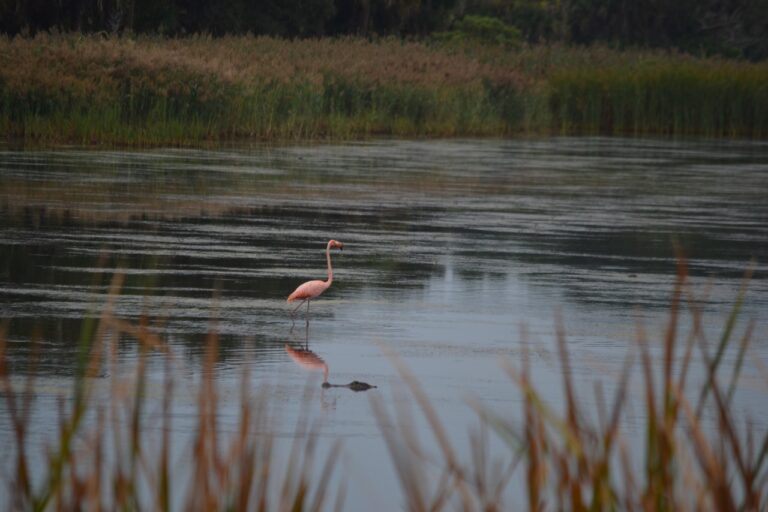
When viewing that image later of the flamingo and alligator, a nuance of the photo stood out – the alligator seemed to be nuzzling the neck of the flamingo’s reflection. This detail was not apparent when taking the photo, but was revealed after the image was moved from camera to computer. It reminded me of another photo I took one day when photographing a fox squirrel on this same dike. In the distance was a dark body, appearing to be mammal and not alligator. Soon we saw a group of four cross the dike and go off into the forest. Inspection of the photo later, zooming in on a bench close to the distant animal, revealed what appeared to be the tail of a cat, surely a bobcat. Of the many shots I took of the flamingo that day, this one with the photobombing alligator became one I have shared multiple times.
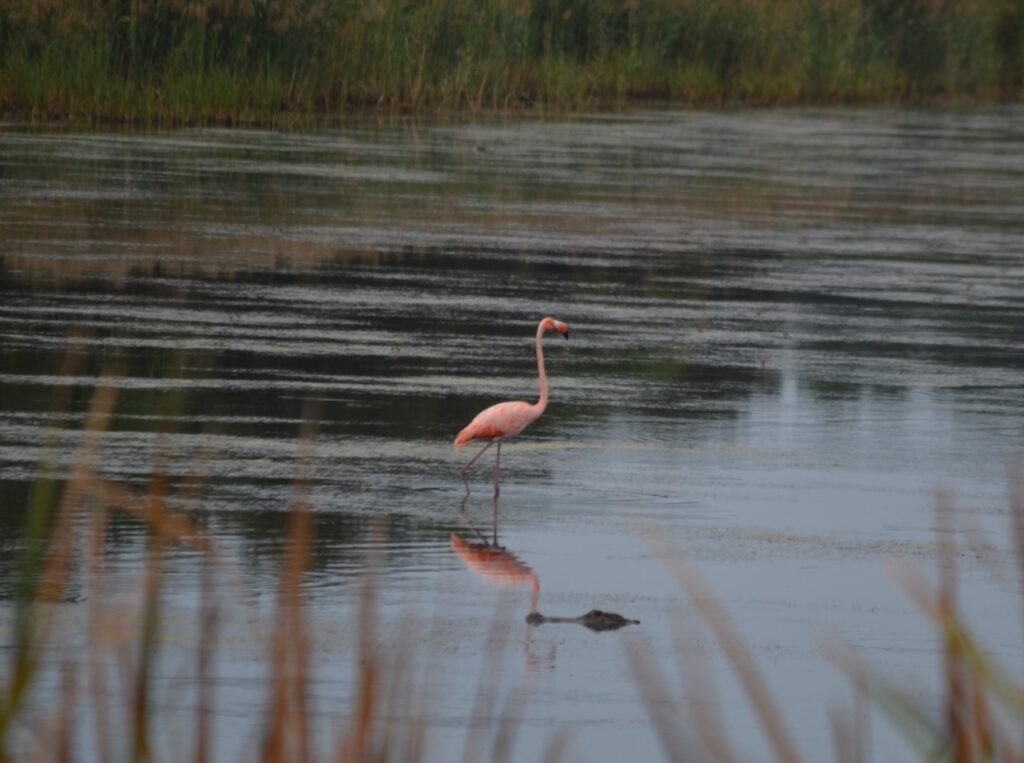
Image captured – mission accomplished, I returned toward the Summerhouse Road, and ran into the birding couple from Wisconsin. The woman had already been out another day to see the flamingo, and knew where to look. I headed south on the Summerhouse Road, planning a southern walk to begin a longer loop. At the upper end of the Summerhouse Pond the maritime forest opened up to views across the marsh to the mainland on one side, and the full extent of the impoundment on the other. That openness allowed some respite from the mosquitoes. At the other end of the pond, perhaps a half mile away, the pink splotch of the bird appeared.
I continued south on Summerhouse until connecting with Mill Road. This walk is definitely the path less traveled, and even a sign announces “Dead End Road”; I have never seen another person on this path. It was a fine walk through maritime forest, excepting the active mosquito population. I had long sleeves, and added a neck gaiter earlier, but my hands and much of my face were still bare. It has been some time since I have done this walk, and it was over a mile until I would meet up with the path to the beach.
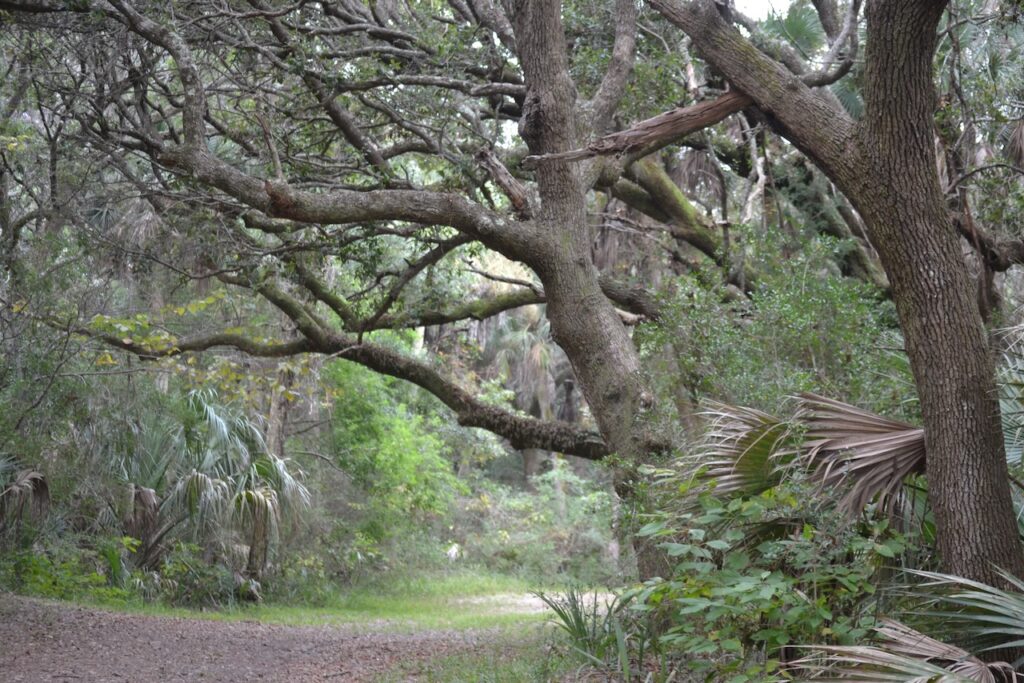
Pink blooms along the road and the path to the beach attracted butterflies common to my garden – the gulf fritillary. They probed for nectar from the blooms, and flitted in the air from plant to plant. I made my way to the path through the dunes, and recalled first seeing sweetgrass blooming here. The incessant whine of the mosquitoes gave way to the surf’s drone, and an ocean vista with a shrimp trawler at work a couple hundred yards off the strand.
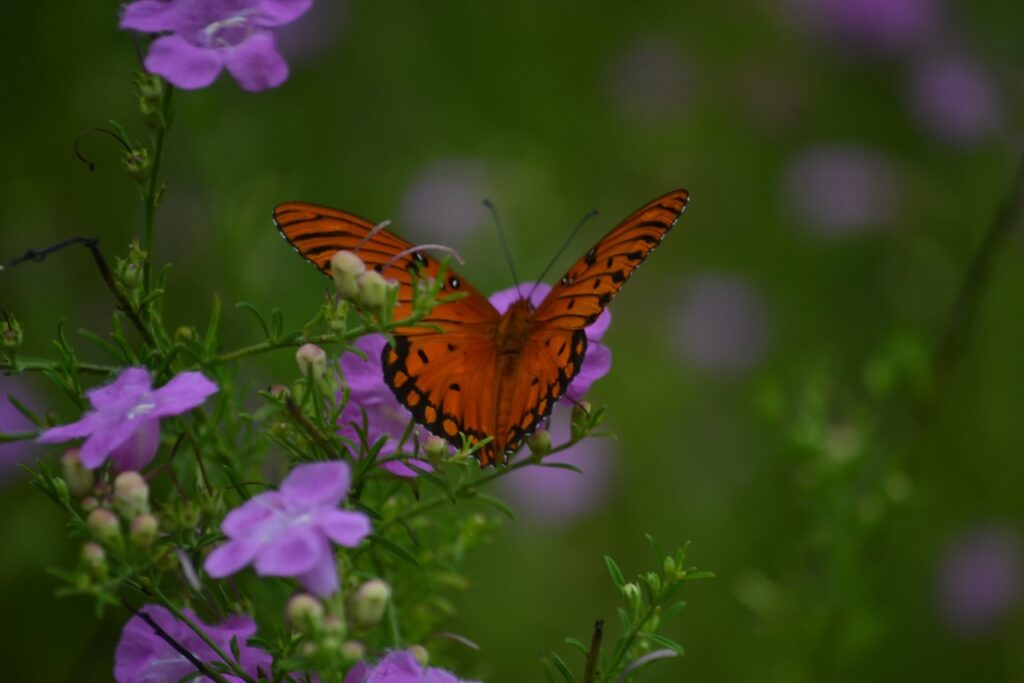
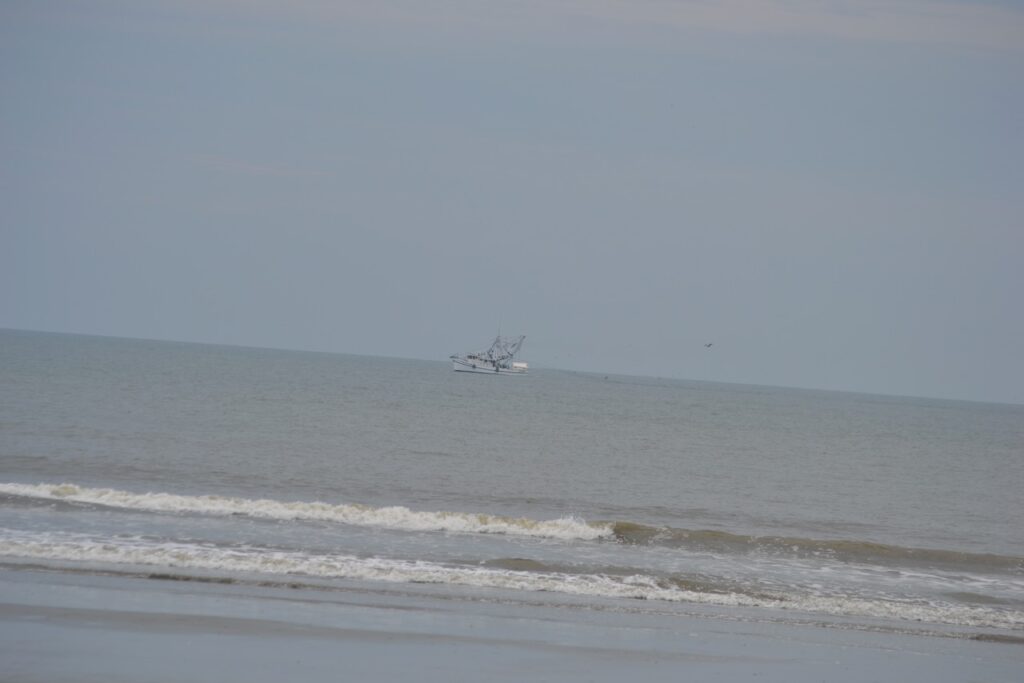
Miles of open beach stretched in both directions as I turned to the north for a long leisurely walk, relieved from the mosquito assault. The astronomical high tides accompanying Tropical Storm Idalia had wrought havoc on what had been an intact dune system in this section of the island. A well placed loggerhead nest high in the dunes had succumbed to the surge.
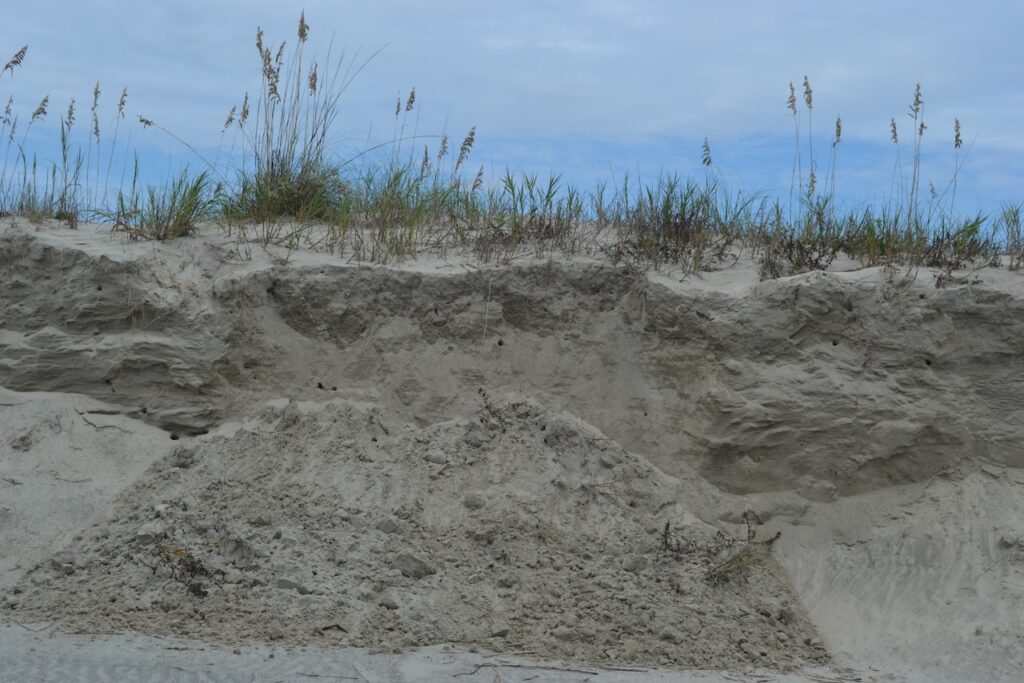
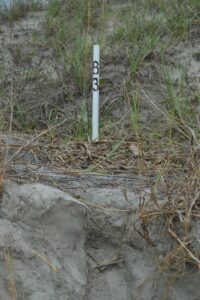
I continued the long walk to my stopping point, the beginning of the Boneyard, enjoying the solitude and exploring the deposited shells. Inspecting the wooden vessel protruding from the sand, I was disappointed to not find more exposure of the frame from the storm tides. I saw fellow passengers at rest, and I found my own log to sit on for lunch.
As I started my return walk to the entrance of the Beach Road, a gulf fritillary landed on the pants of my lower leg. It clung to the cloth and lingered as I began the walk. As I passed other passengers I showed off my companion, and after over a mile made it to the intersection with the road. Other gulf fritillaries flew along the edge of the dunes, and my hitchhiker cast off to sail along with them.
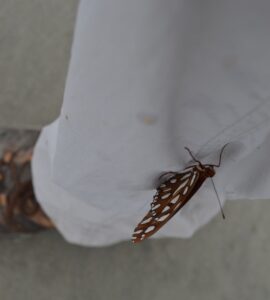
Al the ferry captain had driven a truck across the island to transport ferry passengers choosing to take the ride back to the landing. I dropped off my bagged garbage on the truck, but opted to make the return walk. Walking with several other passengers ahead of the truck, I alerted them to the water control structure where young alligators frequently resided. I have often walked out on the boards at the structure, but they were occupied.
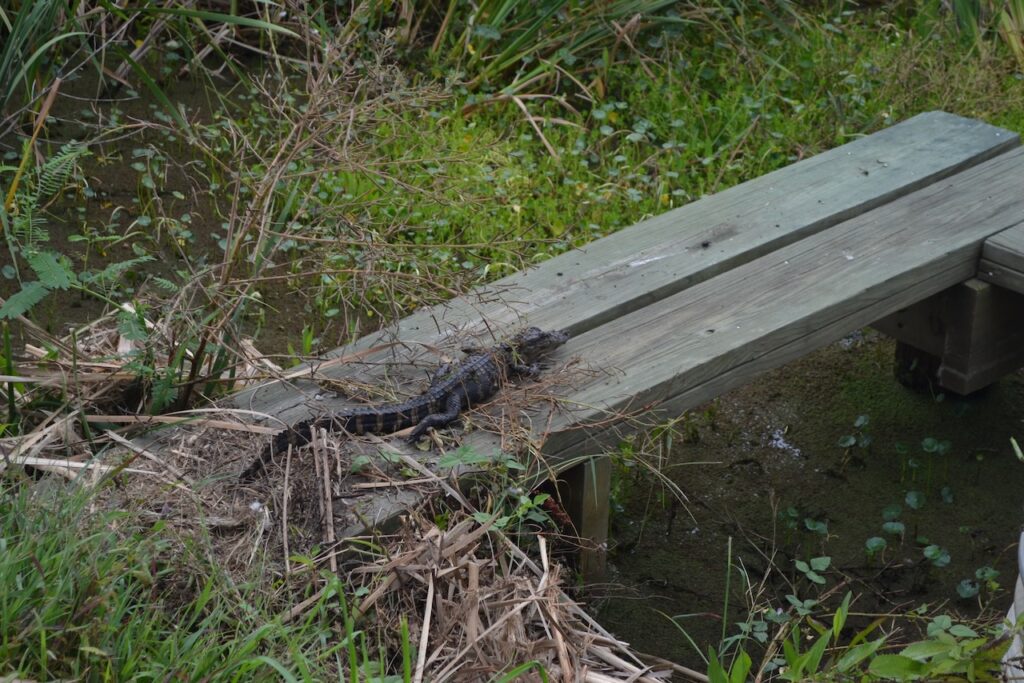
The ferry departed on schedule for the return to the mainland, and the happy and tired group settled in for the ride, enlivened by Annie’s talk and display of nature objects. Disembarking at the dock, the group made their way to the parking lot over the concrete pier. The Wisconsin couple ahead no longer had their binoculars in use. I called out as an osprey passed over their heads flying south. With a final flourish a roseate spoonbill gave us one last flash of pink as it flew in the opposite direction.
Another wonderful walk on Bull Is.! Growing up in Fla. Flamingos are not unknown to me but seeing them here is a treat to those who don’t normally get to see them.
Yes, lots of people got the treat. Not sure if he/she/they have flown back south.
Love your descriptive writing and great photos. Feel like I’m walking along with you.
Let’s take that walk soon
Thanks for the great photos and commentary, Bob. BTW your book arrived in my mailbox yesterday! Felicitations — Bill G from Tremont
And thanks for dropping in for this post. Be on the lookout for accidentals in your neck of the woods. One more thanks for ordering my book.
I really enjoyed this virtual visit, thank you! Welcome to the Fellowship of Jimmy https://adairholland.com/2023/10/03/dominick-house-with-coastal-expeditions/
https://adairholland.com/2023/10/03/dominick-house-with-coastal-expeditions/
Thanks. Is that like the Fellowship of Zilla?
Hi Bob, an interesting post with morning coffee and pancakes, the first I’ve heard of this. I wonder if this flamingo gets lonely or is just confused? Another victim of climate change-supercharged hurricanes. Happy Thanksgiving!
What, you have missed flamingo mania, even flamingo palooza? Expect it to head back south. Those supercharged hurricanes have me concerned about other things than accidentals. Happy Thanksgiving, can’t wait to partake of some of those pancakes.
Great post and beautiful pictures!
Love the photo bomb picture – You need to add to your next book!!!
You keep mentioning that next book – patience…
Great photos!
Thanks!
Thank you, Bob, for a beautiful essay and an incredible photo. How lucky were you to capture this moment! Wish I could join you, the butterflies, the gators, and even the mosquitos for a walk on Bull’s Island.
Thanks, more walks in the future
You survived the mosquito assault. My group made it .25 miles in the mosquito assault before returning to the boat. We beached at south
Bulls, and had a great hike for an hour up the low tide beach.
Thanks for taking one for the team to get the Flamingo shot!!
I admit it was a mission to get the shot. But always, so much more out there.